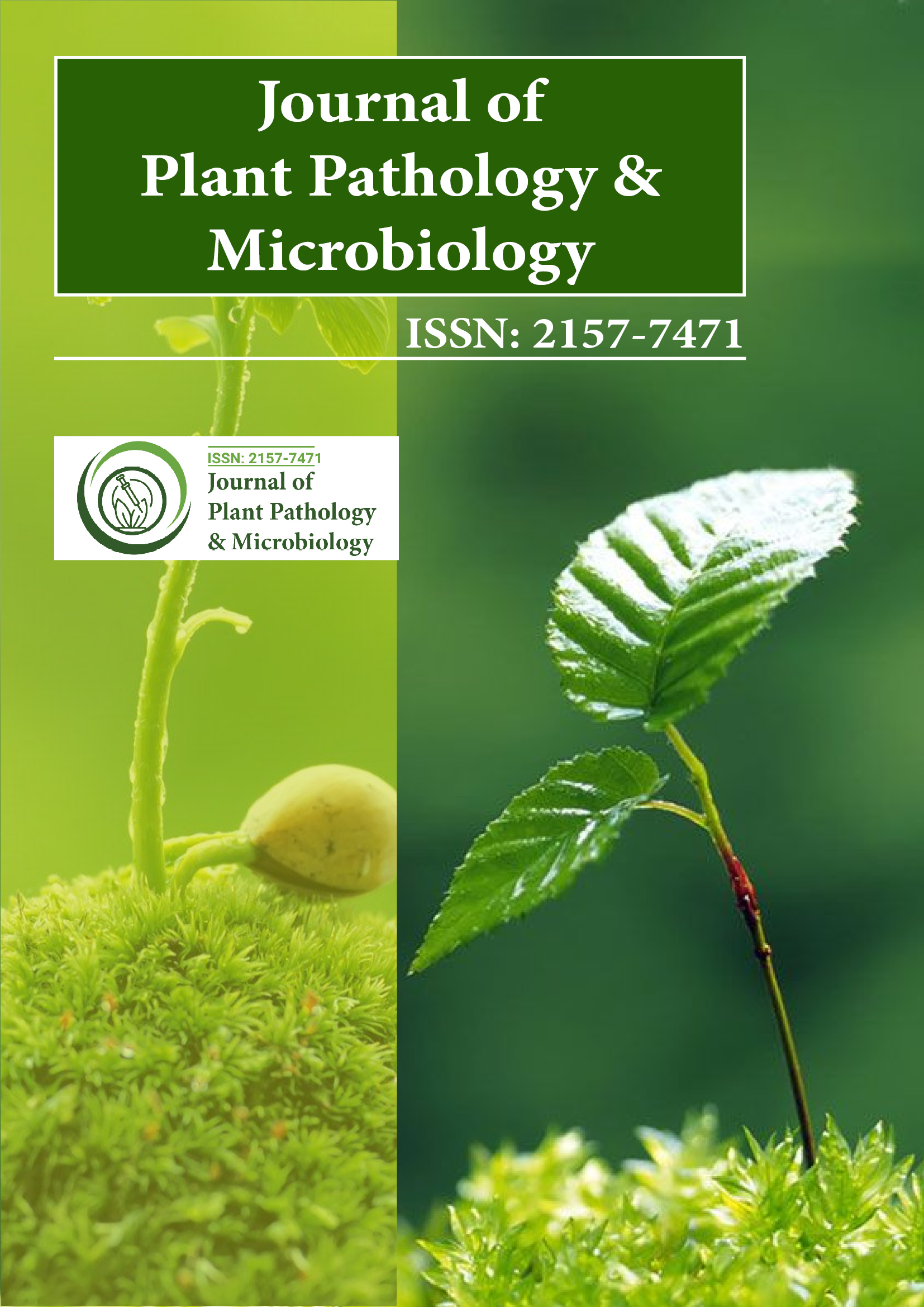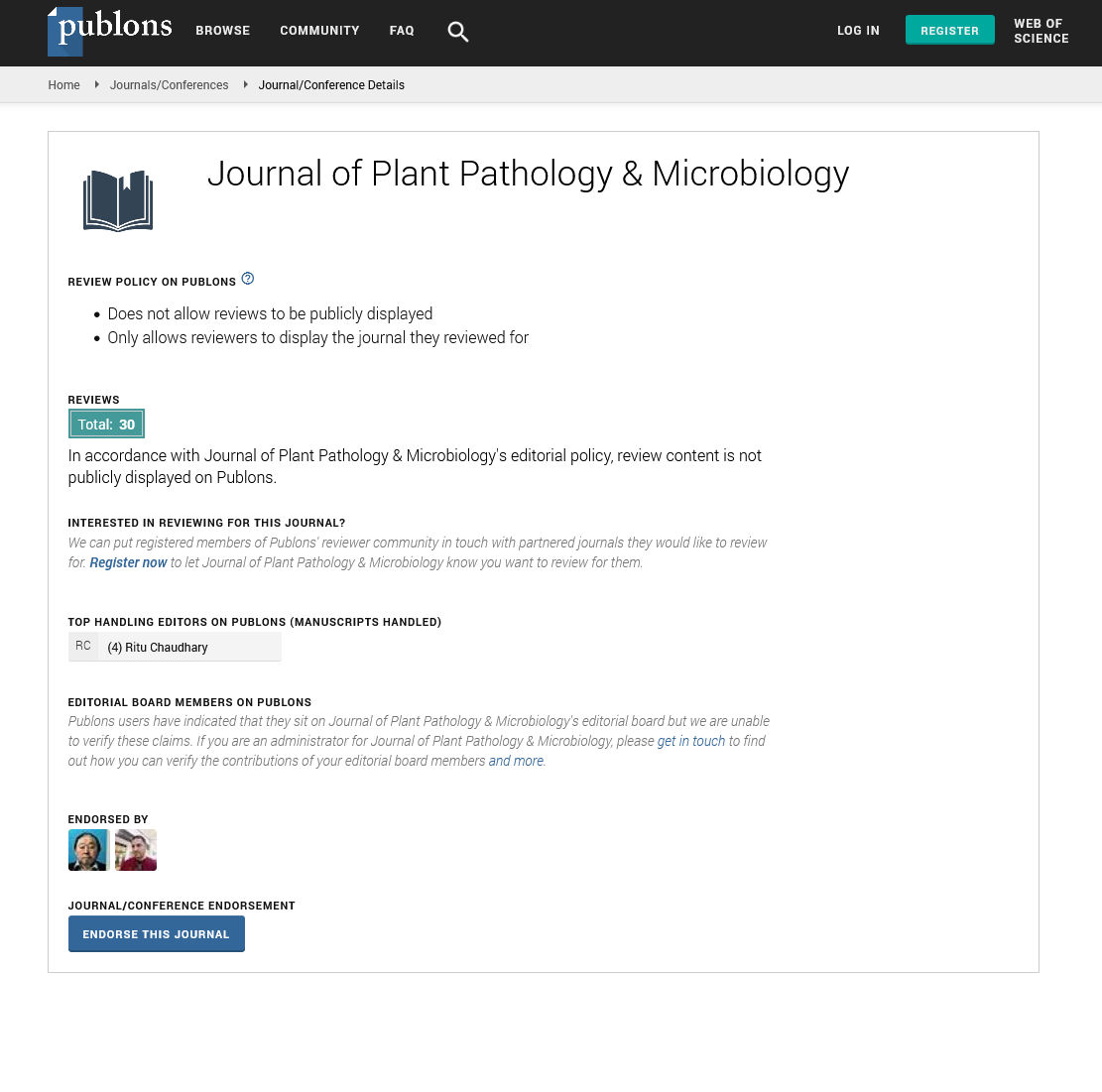Indexed In
- Open J Gate
- Genamics JournalSeek
- Academic Keys
- JournalTOCs
- CiteFactor
- Ulrich's Periodicals Directory
- Access to Global Online Research in Agriculture (AGORA)
- Electronic Journals Library
- Centre for Agriculture and Biosciences International (CABI)
- RefSeek
- Directory of Research Journal Indexing (DRJI)
- Hamdard University
- EBSCO A-Z
- OCLC- WorldCat
- Scholarsteer
- SWB online catalog
- Virtual Library of Biology (vifabio)
- Publons
- Geneva Foundation for Medical Education and Research
- Euro Pub
- Google Scholar
Useful Links
Share This Page
Journal Flyer

Open Access Journals
- Agri and Aquaculture
- Biochemistry
- Bioinformatics & Systems Biology
- Business & Management
- Chemistry
- Clinical Sciences
- Engineering
- Food & Nutrition
- General Science
- Genetics & Molecular Biology
- Immunology & Microbiology
- Medical Sciences
- Neuroscience & Psychology
- Nursing & Health Care
- Pharmaceutical Sciences
Articles published in Journal of Plant Pathology & Microbiology have been cited by esteemed scholars and scientists all around the world. Journal of Plant Pathology & Microbiology has got h-index 44, which means every article in Journal of Plant Pathology & Microbiology has got 44 average citations.
Following are the list of articles that have cited the articles published in Journal of Plant Pathology & Microbiology.
| 2024 | 2023 | 2022 | 2021 | 2020 | 2019 | 2018 | 2017 | 2016 | 2015 | 2014 | 2013 | 2012 | 2011 | 2010 | |
|---|---|---|---|---|---|---|---|---|---|---|---|---|---|---|---|
Total published articles |
36 | 58 | 61 | 61 | 47 | 19 | 43 | 38 | 65 | 100 | 37 | 58 | 42 | 13 | 2 |
Research, Review articles and Editorials |
3 | 9 | 28 | 43 | 46 | 14 | 39 | 37 | 56 | 93 | 33 | 57 | 34 | 9 | 2 |
Research communications, Review communications, Editorial communications, Case reports and Commentary |
20 | 47 | 33 | 18 | 1 | 5 | 4 | 1 | 9 | 7 | 4 | 1 | 8 | 4 | 0 |
Conference proceedings |
0 | 0 | 0 | 0 | 0 | 0 | 72 | 43 | 50 | 0 | 0 | 0 | 0 | 0 | 0 |
Citations received as per Google Scholar, other indexing platforms and portals |
684 | 797 | 1041 | 1046 | 925 | 735 | 587 | 529 | 413 | 313 | 163 | 52 | 0 | 0 | 0 |
| Journal total citations count | 7408 |
| Journal impact factor | 1.85 |
| Journal 5 years impact factor | 1.52 |
| Journal cite score | 18.194 |
| Journal h-index | 44 |
Important citations
Patkowska E. COVER CROPS AND SOIL-BORNE FUNGI DANGEROUS TOWARDS THE CULTIVATION OF Daucus carota L. ACTA SCIENTIARUM POLONORUM-HORTORUM CULTUS. 2021 Jan 1;20(2):3-12.
Abdulmoohsin RG, Lahuf AA, Husain YN, Hameed ZL. Bioefficiency of some indigenous biocontrol agents against Rhizoctonia solani causing cowpea seed rot and preemergence damping-off. InIOP Conference Series: Earth and Environmental Science 2019 Nov 1 (Vol. 388, No. 1, p. 012011). IOP Publishing.
Abdulmoohsin RG, Lahuf AA, Husain YN, Hameed ZL. Bioefficiency of some indigenous biocontrol agents against Rhizoctonia solani causing cowpea seed rot and preemergence damping-off. InIOP Conference Series: Earth and Environmental Science 2019 Nov 1 (Vol. 388, No. 1, p. 012011). IOP Publishing.
Lacey JV. Evaluation of Trichoderma Spp. as Biocontrol Agents for Soybean Diseases.
Wangkhem B, Rana M, Jackson KS. Exploring the control measures of white rust-organic amendments, botanicals, biocontrol agents and chemicals. Journal of Pharmacognosy and Phytochemistry. 2019;8(3):4413-9.
Win TT, Bo B, Malec P, Khan S, Fu P. Newly isolated strain of Trichoderma asperellum from disease suppressive soil is a potential bio-control agent to suppress Fusarium soil borne fungal phytopathogens. Journal of Plant Pathology. 2021 May;103(2):549-61.
Pandey RN, Jaisani P, Yadav DL. Trichoderma spp. in the management of stresses in plants and rural prosperity. Indian Phytopathology. 2021 May 5:1-5.
Pun LB, Chhetri K, Pandey A, Poudel R. In vitro Evaluation of Botanical Extracts, Chemical Fungicides and Trichoderma harzianum Against Alternaria brassicicola Causing Leafspot of Cabbage. Nepalese Horticulture. 2020 Aug 26;14(1):68-76.
Pun LB, Chhetri K, Pandey A, Poudel R. In vitro Evaluation of Botanical Extracts, Chemical Fungicides and Trichoderma harzianum Against Alternaria brassicicola Causing Leafspot of Cabbage. Nepalese Horticulture. 2020 Aug 26;14(1):68-76.
Mahde BY, Fayyadh MA, Al-Luaibi SS. Evaluation of Biofungicide Formulation of Trichoderma longibrachiatum in Controlling of Tomato Seedling Damping-off Caused by Rhizoctonia solani. Basrah J. Agric. Sci.. 2019 Dec 31;32(2):135-49.
Ahmad A, Akram W, Bashir Z, Shahzadi I, Wang R, Abbas HM, Hu D, Ahmed S, Xu X, Li G, Wu T. Functional and structural analysis of a novel acyltransferase from pathogenic Phytophthora melonis. ACS omega. 2021 Jan 13;6(3):1797-808.
Konappa N, Krishnamurthy S, Dhamodaran N, Arakere UC, Ramachandrappa NS, Chowdappa S. Beneficial Effects of Trichoderma on Plant–Pathogen Interactions: Understanding Mechanisms Underlying Genes. InTrichoderma: Agricultural Applications and Beyond 2020 (pp. 41-85). Springer, Cham.
Konappa N, Krishnamurthy S, Dhamodaran N, Arakere UC, Chowdappa S, Ramachandrappa NS. Opportunistic Avirulent Plant Symbionts Trichoderma: Exploring Its Potential Against Soilborne Phytopathogens. InTrichoderma: Agricultural Applications and Beyond 2020 (pp. 219-255). Springer, Cham.
Radhi MN. Evaluation the efficiency of packing cucumber seeds with alginic acid loaded on Trichoderma koningii spores for time periods against pathogenic fungus Rhizoctonia solani. InJournal of Physics: Conference Series 2019 Sep 1 (Vol. 1294, No. 9, p. 092019). IOP Publishing.
Jaiganesh V. Chapter-2 Crop Disease Management through Bio-Protectants. Current Research and Innovations in Plant Pathology. 2019:21.
Gupta S, Didwania N, Singh D. Biological control of mustard blight caused by Alternaria brassicae using plant growth promoting bacteria. Current Plant Biology. 2020 Sep 1;23:100166.
Taha N, Kamel S, Elsakhawy T, Bayoumi Y, Omara AE, El-Ramady HR. Sustainable Approaches of Trichoderma under Changing Environments for Vegetable Production. Environment, Biodiversity and Soil Security. 2020 Feb 1;4(2020):291-311.
Ali AM. The Competitive Potential of Different Trichoderma spp. to Control Rhizoctonia Root Rot Disease of Pepper (Capsicum annuum L.). Egyptian Journal of Phytopathology. 2021 Jun 1;49(1):136-50.
Yousef SA, Salem SH, EL-Sharkawy HH. Effect of some Chemical Inducers on Antagonistic Potential of Trichoderma harzianum against Rhizoctonia solani and it's Metabolites Production. Journal of Plant Protection and Pathology. 2018 Aug 1;9(8):497-506.
Jackson K, Kumar AD. Management of alternaria leaf spot on indian mustard through chemical and biological agents. Plant cell biotechnology and molecular biology. 2019 May 16;20(3-4):162-78.

